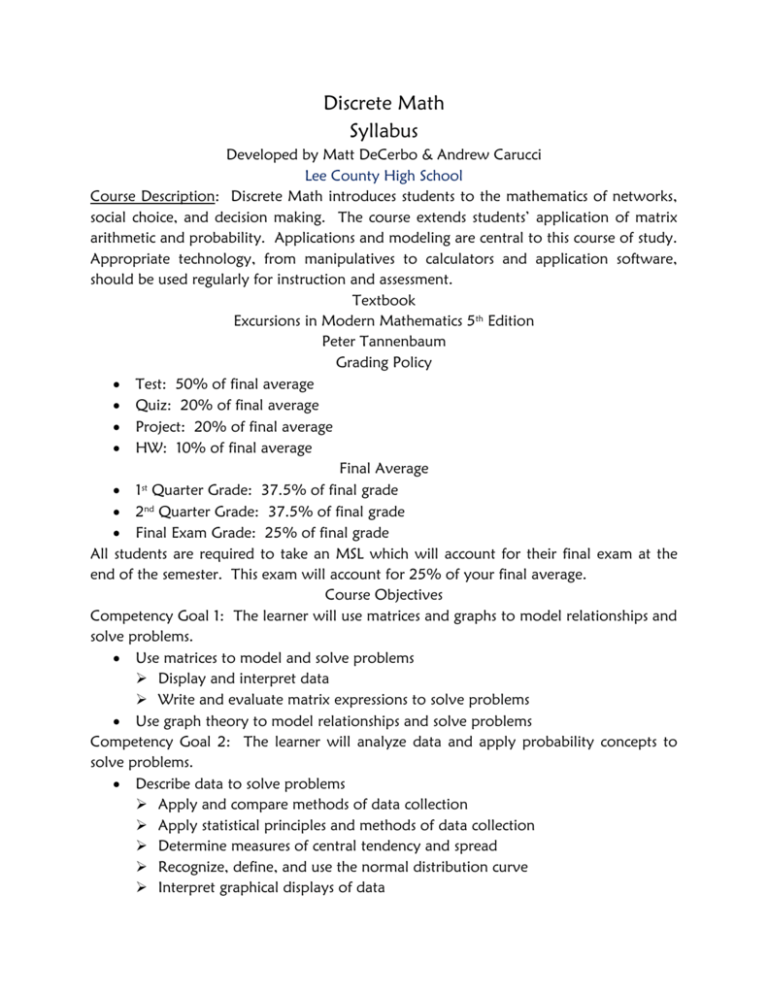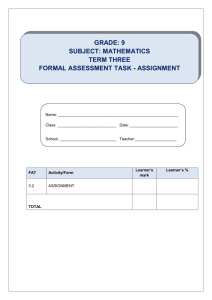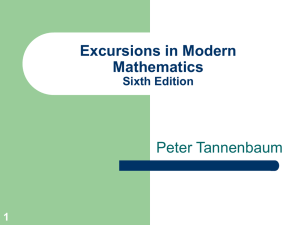Discrete Syllabus - Lee County Schools
advertisement

Discrete Math Syllabus Developed by Matt DeCerbo & Andrew Carucci Lee County High School Course Description: Discrete Math introduces students to the mathematics of networks, social choice, and decision making. The course extends students’ application of matrix arithmetic and probability. Applications and modeling are central to this course of study. Appropriate technology, from manipulatives to calculators and application software, should be used regularly for instruction and assessment. Textbook Excursions in Modern Mathematics 5th Edition Peter Tannenbaum Grading Policy Test: 50% of final average Quiz: 20% of final average Project: 20% of final average HW: 10% of final average Final Average st 1 Quarter Grade: 37.5% of final grade 2nd Quarter Grade: 37.5% of final grade Final Exam Grade: 25% of final grade All students are required to take an MSL which will account for their final exam at the end of the semester. This exam will account for 25% of your final average. Course Objectives Competency Goal 1: The learner will use matrices and graphs to model relationships and solve problems. Use matrices to model and solve problems Display and interpret data Write and evaluate matrix expressions to solve problems Use graph theory to model relationships and solve problems Competency Goal 2: The learner will analyze data and apply probability concepts to solve problems. Describe data to solve problems Apply and compare methods of data collection Apply statistical principles and methods of data collection Determine measures of central tendency and spread Recognize, define, and use the normal distribution curve Interpret graphical displays of data Compare distributions of data Use theoretical and experimental probability to model and solve problems Use addition and multiplication principles Calculate and apply permutations and combinations Create and use simulations for probability models Find expected values and determine fairness Identify and use discrete random variables to solve problems Apply the binomial theorem Model and solve problems involving fair outcomes Apportionment Election theory Voting power Fair division Competency Goal 3: The learner will describe and use recursively-defined relationships to solve problems. Use recursion to model and solve problems Find the sum of a finite sequence Find the sum of an infinite sequence Determine whether a given series converges or diverges Write explicit definitions using iterative process, including finite differences and arithmetic and geometric formulas Verify an explicit definition with inductive proof Course Outline Chapter 1: The Mathematics of Voting – The Paradoxes of Democracy Preference Ballots and Preference Schedules The Plurality Method The Borda Count Method The Plurality with Elimination Method The Method of Pairwise Comparisons Rankings Chapter 2: Weighted Voting Systems – The Power Game Weighted Voting Systems The Banzhaf Power Index Applications of the Banzhaf Power Index The Shapley-Shubik Power Index Chapter 3: Fair Division – The Mathematics of Sharing Fair-Division Games Two Players: The Divider-Chooser Method The Lone-Divider Method The Lone-Chooser Method The Last-Diminisher Method The Method of Sealed Bids The Method of Markers Chapter 4: The Mathematics of Apportionment – Making the Rounds The Apportionment Problem The Mathematics of Apportionment: Basic Concepts Hamilton’s Method and the Quota Rule The Alabama Paradox The Population and New-States Paradox Jefferson’s Method Adam’s Method Webster’s Method Chapter 5: Euler Circuits – The Circuit Comes to Town Routing Problems Graphs Graph Concepts and Terminology Graph Models Euler’s Theorems Fleury’s Algorithm Eulerizing Graphs Chapter 6: The Traveling-Salesman Problem – Hamilton Joins the Circuit Hamilton Circuits and Hamilton Paths Complete Graphs Traveling-Salesman Problems Simple Strategies for Solving TSPs The Brute-Force and Nearest-Neighbor Algorithms Approximate Algorithms The Repetitive Nearest-Neighbor Algorithm The Cheapest Link Algorithm Chapter 7: The Mathematics of Networks – It’s All About Being Connected Trees Minimum Spanning Trees Kruskal’s Algorithm The Shortest Distance Between Three Points The Shortest Network Linking more than Three Points Chapter 8: The Mathematics of Scheduling – Directed Graphs and Critical Paths The Basic Elements of Scheduling Directed Graphs The Priority-List Model for Scheduling The Decreasing-Time Algorithm Critical Paths The Critical-Path Algorithm Scheduling with Independent Tasks Chapter 9: Spiral Growth in Nature Fibonacci Numbers The Equation 𝑥 2 = 𝑥 + 1 and the Golden Ratio Gnomons Gnomonic Growth Chapter 10: The Mathematics of Population Growth The Dynamics of Population Growth The Linear Growth Model The Exponential Growth Model The Logistics Growth Model Chapter 11: Symmetry – Mirror, Mirror, Off the Wall… Geometric Symmetry Rigid Motions Reflections Rotations Translations Glide Reflections Symmetry Revisited Patterns Chapter 12: Fractal Geometry – Fractally Speaking The Koch Snowflake The Sierpinski Gasket The Chaos Game The Twisted Sierpinski Gasket Self-Similarity in Art and Literature The Mandelbrot Set Chapter 13: Collecting Statistical Data – Censuses, Surveys, and Clinical Studies The Population Surveys Random Sampling Sampling: Terminology and Key Concepts Clinical Studies Chapter 14: Descriptive Statistics Graphical Descriptions of Data Variables: Quantitative and Qualitative; Continuous and Discrete Numerical Summaries of Data Measures of Spread Chapter 15: Chances, Probabilities, and Odds – Measuring Uncertainty Random Experiments and Sample Spaces Counting: The Multiplication Rule Permutations and Combinations What is a Probability? Probability Spaces Probability Spaces with Equally Likely Outcomes Odds Chapter 16: Normal Distributions – Everything is back to Normal (Almost) Approximately Normal Distributions of Data Normal Curves and Normal Distributions Standardizing Normal Data Sets The 68-95-99.7 Rule Normal Curves as Models of Real-Life Data Sets Normal Distributions of Random Events Statistical Inference






